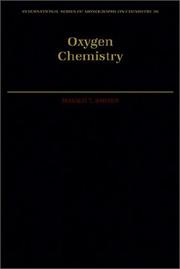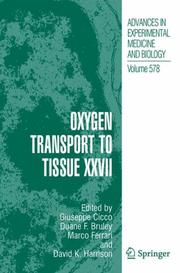| Listing 1 - 10 of 514 | << page >> |
Sort by
|
Periodical
ISSN: 26739801
Abstract | Keywords | Export | Availability | Bookmark
 Loading...
Loading...Choose an application
- Reference Manager
- EndNote
- RefWorks (Direct export to RefWorks)
Book
ISBN: 9815036637 9815036645 9789815036633 Year: 2021 Publisher: Singapore Bentham Science Publishers
Abstract | Keywords | Export | Availability | Bookmark
 Loading...
Loading...Choose an application
- Reference Manager
- EndNote
- RefWorks (Direct export to RefWorks)
This book presents information about the high enzymatic reactivity of reactive oxygen species. Chapters in the book cover several aspects of the topic such as the sources, formation mechanisms, reaction centers, oxidation-reduction reactions, cellular respiration chemistry, enzymatic kinetics, mitochondrial and plastid electron transport chains, oxidation-reduction potential, reaction constants, reaction velocity and reaction mechanisms involved, cellular cytotoxicity, antioxidant defense mechanisms in plants and animals, response of plants to conditions of environmental stress, xenobiotics, and the thermodynamics inherent to oxygen metabolism. The book also features a chapter on flavonoids which highlights a paradoxical facet of the affinity of reactive oxygen species for enzymes. Flavonoids are mainly antioxidant molecules as they act as trappers of reactive oxygen species. The chapter informs readers about the metabolic pathways mediated by enzymes through wich flavonoids become promoters of these same reactive oxygen species. All chapters present the subject in a simple, analytical format, while highlighting the scientific evidence gathered by researchers so far. The volume is an interesting reference for scholars learning about the biochemistry and enzymology of oxygen and its free radical derivatives.
Book
ISBN: 9789815036633 Year: 2021 Publisher: Singapore : Bentham Science Publishers,
Abstract | Keywords | Export | Availability | Bookmark
 Loading...
Loading...Choose an application
- Reference Manager
- EndNote
- RefWorks (Direct export to RefWorks)
This book presents information about the high enzymatic reactivity of reactive oxygen species. Chapters in the book cover several aspects of the topic such as the sources, formation mechanisms, reaction centers, oxidation-reduction reactions, cellular respiration chemistry, enzymatic kinetics, mitochondrial and plastid electron transport chains, oxidation-reduction potential, reaction constants, reaction velocity and reaction mechanisms involved, cellular cytotoxicity, antioxidant defense mechanisms in plants and animals, response of plants to conditions of environmental stress, xenobiotics, and the thermodynamics inherent to oxygen metabolism. The book also features a chapter on flavonoids which highlights a paradoxical facet of the affinity of reactive oxygen species for enzymes. Flavonoids are mainly antioxidant molecules as they act as trappers of reactive oxygen species. The chapter informs readers about the metabolic pathways mediated by enzymes through wich flavonoids become promoters of these same reactive oxygen species. All chapters present the subject in a simple, analytical format, while highlighting the scientific evidence gathered by researchers so far. The volume is an interesting reference for scholars learning about the biochemistry and enzymology of oxygen and its free radical derivatives.
Book
Abstract | Keywords | Export | Availability | Bookmark
 Loading...
Loading...Choose an application
- Reference Manager
- EndNote
- RefWorks (Direct export to RefWorks)
The term "reactive oxygen species" (ROS) refers to a group of reactive molecules and free radicals produced by molecular oxygen. In recent decades, there has been great interest in the role of ROS in various diseases. From basic science research to clinical trials, biomedical scientists have made rapid progress toward a better understanding of ROS-metabolizing systems and their role in health and diseases. This book includes sixteen chapters that address topics such as the history of ROS, its role in autoimmunity, neurodegeneration, and aging, and recent advances in various antioxidants and their therapeutic potential.
Multi
ISBN: 9780128224960 0128224967 0128224819 9780128224816 Year: 2020 Publisher: London, England : Academic Press,
Abstract | Keywords | Export | Availability | Bookmark
 Loading...
Loading...Choose an application
- Reference Manager
- EndNote
- RefWorks (Direct export to RefWorks)
"Covers the ecotoxicology of environmental heavy metal ions and the interactions between specific heavy metals-induced cell responses and oxidative stress Provides a better understanding of the mechanism of nanomaterial-induced toxicity as a first defense for hazard prevention Covers recent advances in new nanomedication technologies for the effects of NPs on oxidative stress, ROS and ER stress Discusses the effects of interactions between antioxidant defense therapy, ROS and strategies for treatment"--

ISBN: 0197560113 1280523867 9786610523863 1423735544 0195363329 1601297289 9781423735540 9781601297280 9780195057980 0195057988 0195057988 Year: 2020 Publisher: New York : Oxford University Press,
Abstract | Keywords | Export | Availability | Bookmark
 Loading...
Loading...Choose an application
- Reference Manager
- EndNote
- RefWorks (Direct export to RefWorks)
Sawyer's book places oxygen on the centre stage of chemistry in a manner that parallels the focus on carbon by 19th century chemists. One measure of the significance of oxygen chemistry is the greater diversity of oxygen-containing molecules than that of carbon-containing molecules. One of the most important compounds is water, containing the properties of being a unique medium for biological chemistry and life, the source of all the dioxygen in the atmosphere, and the moderator of the earth's climate.
Oxygen. --- Chalcogens --- Nonmetals --- Photosynthetic oxygen evolution
Book
ISBN: 2759825361 Year: 2021 Publisher: [Place of publication not identified] : EDP Sciences,
Abstract | Keywords | Export | Availability | Bookmark
 Loading...
Loading...Choose an application
- Reference Manager
- EndNote
- RefWorks (Direct export to RefWorks)
This book describes and comments on the results of research devoted to the studies of phase assemblages in the CaO-SiO2-Al2O3-Fe oxides chemical system, their stability and their evolution in our environment (temperature, pressure). Its aim is to be a research support, not only for researchers and development engineers but also more generally for others interested in materials sciences. The book is divided in two parts; the first devoted to a description of ‘the system’ using phase diagrams. The second explores the properties and uses of some of the minerals that are in widespread industrial and commercial use. Much of the work presented in this book is fully original and corresponds to the research undertaken by François Sorrentino from his time at the chemistry department of the University of Aberdeen during the early 1970’s, to recent years when he has resumed his interest in mineral research, particularly related to the synthesis of calcium silicates and calcium aluminates, and their industrial manufacture.
Oxides. --- Chalcogenides --- Oxygen compounds
Book
ISBN: 161209466X 9781612094663 9781611225020 1611225027 Year: 2011 Publisher: Hauppauge, N.Y.
Abstract | Keywords | Export | Availability | Bookmark
 Loading...
Loading...Choose an application
- Reference Manager
- EndNote
- RefWorks (Direct export to RefWorks)
Book
Year: 2012 Publisher: EDP SCIENCES
Abstract | Keywords | Export | Availability | Bookmark
 Loading...
Loading...Choose an application
- Reference Manager
- EndNote
- RefWorks (Direct export to RefWorks)
This book, written by a group of specialists in the different areas involved, summarises what we understand of the production and distribution of oxygen, the most abundant metal in the Universe. After presenting the methods of oxygen abundance determination in various media, it traces a panorama of oxygen in the Universe, describes the mechanisms and sites of oxygen production and finally discusses the chemical evolution of oxygen in different galactic and extra galactic contexts. An appendix thoroughly discusses the oxygen atomic data.

ISBN: 1280700890 9786610700899 0387295402 0387295437 Year: 2006 Publisher: New York : Springer,
Abstract | Keywords | Export | Availability | Bookmark
 Loading...
Loading...Choose an application
- Reference Manager
- EndNote
- RefWorks (Direct export to RefWorks)
Proceedings of the 32nd scientific meeting of the International Society on Oxygen Transport to Tissue (ISOTT) in Bari, Italy, August 21-26, 2004.
Oxygen --- Tissue respiration --- Physiological transport --- Chalcogens --- Nonmetals --- Photosynthetic oxygen evolution
| Listing 1 - 10 of 514 | << page >> |
Sort by
|

 Search
Search Feedback
Feedback About UniCat
About UniCat  Help
Help News
News